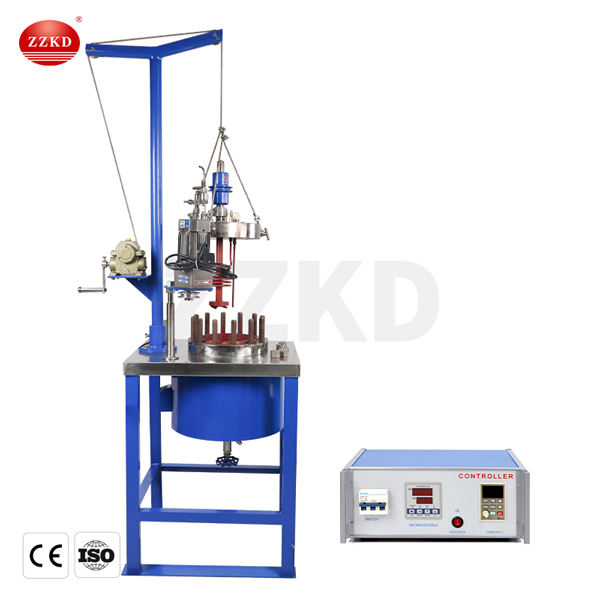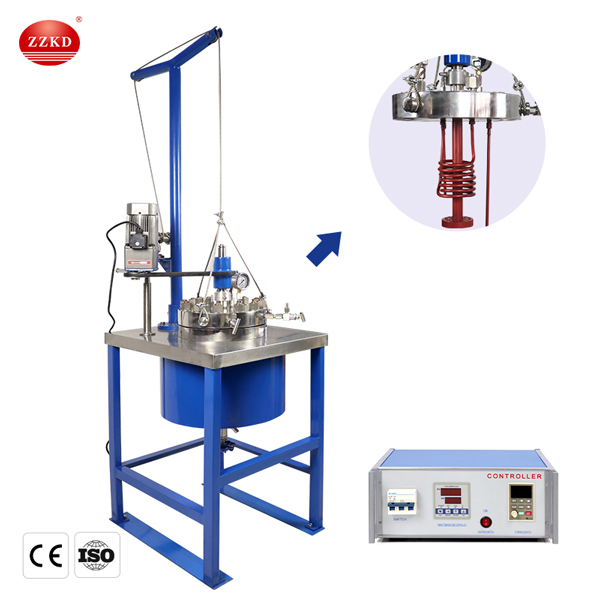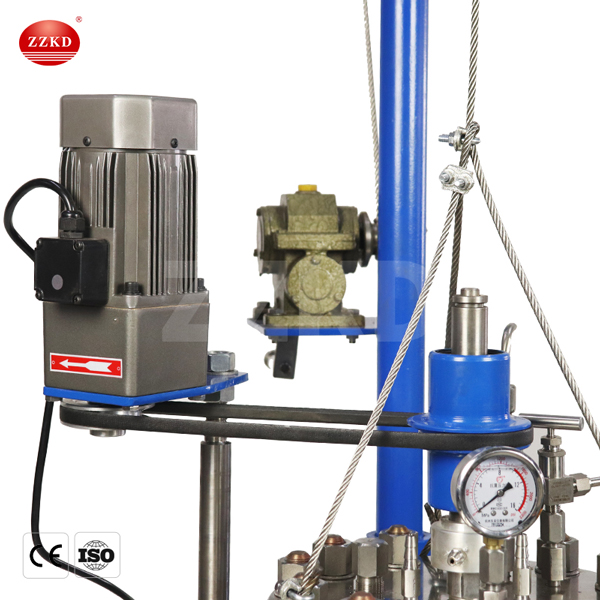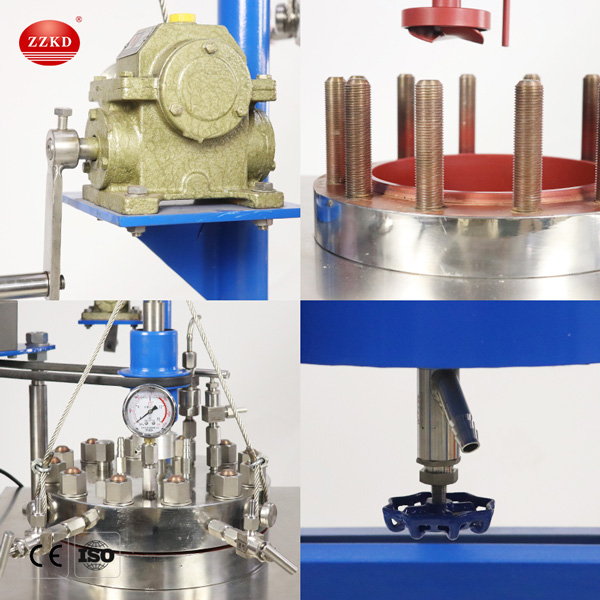- +86 17324835373
- [email protected]
- 19/F, Block B, Guohong Mansion, Zhengzhou, Henan, China
The main feature of the high pressure reactor laboratory is the static seal structure, and the static seal is used instead of the dynamic seal. The stirrer and motor drive are connected by a magnetic coupling. Non-contact torque transmission completely solves the problem of poor sealing of materials during direct stirring. The entire medium and stirring section is completely sealed. Laboratory high-pressure reactors are more suitable for various flammable, explosive, highly toxic, precious media and other chemical media with strong permeability. It is the process of petroleum, chemistry, organic synthesis, polymerization of polymer materials, and food. The most ideal leak-free reaction equipment for vulcanization, fluorination, hydrogenation, etc.

1. Various chemical raw materials can be fully stirred under high pressure, vacuum and temperature to enhance the mass transfer and heat transfer process;
2. Static sealing, no leakage, the seal between the static ring and the static ring seat of the reactor, no O-ring, depending on the structural characteristics of each, the contact stress increases with the working pressure, and the sealing performance is better under high pressure of;
3. The safety valve of the high-pressure reactor in the laboratory adopts a bursting diaphragm, which has a small error in the bursting value, fast instantaneous exhaust speed, and is safe and reliable;
4. The valves of the high pressure reactor laboratory adopt needle valves, which are reciprocatingly closed, reliable in sealing and durable in use. Various valves are installed reasonably and the discharge is smooth;
5. The pressure gauge of the high pressure reactor laboratory has good anti-vibration performance and is suitable for places with severe environmental vibration. It can withstand the pulsation, impact and sudden unloading of the medium, and the indication is stable and clear;
6. Intelligent digital display temperature control meter, with automatic temperature control function, speed display and stepless speed regulation function, equipped with heating electric heat meter, motor ammeter, and working time display meter.

1. Add water to the high pressure reactor laboratory, install the lid of the autoclave, and tighten the screws according to the above operation.
2. Pour nitrogen into the high pressure reactor laboratory to about 0.7MPa, test the pressure for 30 minutes, and see if the pressure changes to determine whether there is an air leak. If there is an air leak, first release the nitrogen in the high-pressure reactor and re-tighten the screws.
3. After the pressure test is over, release the nitrogen in the high pressure reactor laboratory.
4. Turn on the power, start stirring and heating, control the stirring speed, control the heating and heating speed within 100°C/h, and at the same time pass the cooling water to the stirring shaft to cool.
5. Set the temperature at about 160°C, and record the pressure values in the autoclave at different temperatures. During the experiment, record a pressure value every 10°C.
6. At the end of the experiment, first pass the cooling water to cool the kettle liquid to below 80°C, open the high-pressure reaction kettle, and release the pressure in the kettle.
7. Open the lid of the high pressure reactor laboratory, clean the body of the autoclave, and turn off the cooling water and power supply.

1. The parts in contact with the materials in the high pressure reactor laboratory are made of high-quality stainless steel such as 304 or 316L, which meets the GMP standard. All parts in contact with materials are made of Hastelloy, including various valves and pipelines.
2. High pressure reactor laboratory is mainly composed of three parts: tank body, jacket and stirring system. The inner surface of the high pressure reactor laboratory is mirror polished to ensure that there are no hygienic dead ends. The fully enclosed design ensures that the material is always in a sterile state. The outer surface of the high pressure reactor laboratory can be sandblasted, frosted, or cold-rolled.
3. The high-pressure reaction kettle in the laboratory adopts a quick-opening structure, which has functions such as the lowering of the kettle body and the dumping mechanism. Its parts layout is reasonable, the structure is compact, and the installation and operation are extremely convenient.
4. The safety valve adopts a bursting diaphragm, which has a small error in the bursting value, fast exhaust speed in an instant, and is safe and reliable. Needle valve, reciprocating switch structure, durable and reliable sealing. All kinds of valves are installed reasonably, and the discharge is smooth and there is no dead angle. The feed port is equipped with a pipe-type valve to facilitate feeding. The opening of the kettle cover is as shown in the design drawing. The external pipe of the spare port is bent at about 120 degrees, which is convenient for connecting hoses and other equipment. Set the lower discharge valve to achieve the purpose of reducing the number of openings and facilitating the discharge. The lower discharge valve is a lower expansion valve, so there is no dead angle for stirring.
5. The high pressure reactor laboratory kettle is equipped with a backup pressure valve, which can adjust the pressure of 1~5 MPa, so that the pressure in the kettle can be controlled and balanced.
6. The heating method of the high pressure reactor laboratory can be steam, electric heating, or heat transfer oil to meet the technological needs of different working environments such as acid resistance, alkali resistance, high temperature resistance, abrasion resistance, and corrosion resistance.

FCF-0.1, FCF-0.25, FCF-0.5, FCF-1, FCF-2, FCF-3, FCF-5, FCF-10, FCF-20, FCF-30, etc.
It consists of kettle body, kettle cover, magnetic stirrer, heater, valve, feed inlet, internal cooling coil, safety sandblasting device, pressure gauge, controller, lifting device, etc.
Model | FCF-0.05 | FCF-0.1 | FCF-0.25 | FCF-0.5 | FCF-1 | FCF-2 | FCF-3 | FCF-5 | FCF-10 |
Capacity(L) | 0.05 | 0.1 | 0.25 | 0.5 | 1 | 2 | 3 | 5 | 10 |
Setting Pressure(MPa) | 22 | ||||||||
Setting Temperature(℃) | 350 | ||||||||
Accuracy of Temperature Control | ±1 | ||||||||
Heating Method | General electric heating, others are far-infrared, thermal iol, steam, circulating water, etc | ||||||||
Stirring Torque(N.cm) | 120 | ||||||||
Heating Power(kw) | 0.6 | 0.8 | 1.5 | 2 | 2.5 | 4 | 7 | ||
Temperature Controller | Real-time display and adjust the speed, temperature, time, with standard PID automatic temperature adjustable meter. | ||||||||
Working Environment | Ambient Temperature 0~50℃,Relative Humidity 30~80%. | ||||||||
Voltage(V/Hz) | 220 50/60 | ||||||||
Please leave your contact information, we will arrange the business staff to contact you as soon as we see the message.
Copyright © 2022. ZZKD machinery equipment co., LTD All rights Sitemap